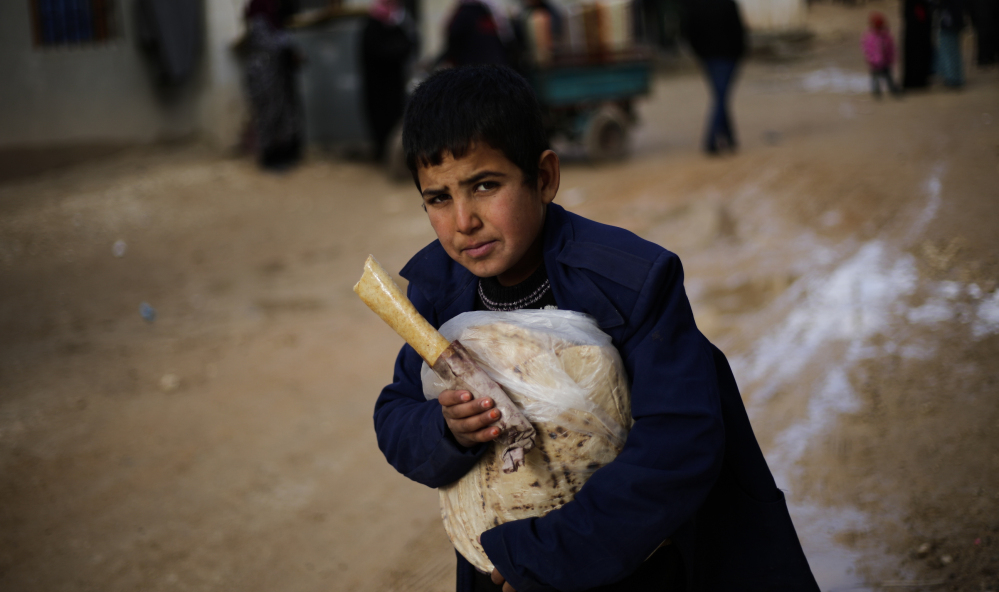JIBREEN, Syria — Azza Haj Hussein held out for four years in war-ravaged eastern Aleppo, moving from one bombed-out home to another and surviving mostly on bread, crushed wheat and rice for four months under a suffocating government siege.
The 27-year-old mother of four recalls days when the family of six had to squeeze themselves into a tiny bathroom to seek shelter from airstrikes that shook the ground beneath them. On Tuesday, troops marched into their neighborhood, placing them on buses headed to government-controlled western Aleppo as rebel defenses crumbled.
She is now among some 3,000 families who have taken refuge in a market that has been turned into a shelter for the thousands who have fled east Aleppo over the past week. In some cases, more than a dozen people are staying in one room where water is scarce despite the municipalities’ work to improve conditions.
On Saturday, relief agencies and Russian troops were busy distributing hot meals, clothes and sleeping bags to help the displaced cope with the shelter’s harsh conditions and the cold weather. Paramedics went from one house to another to vaccinate children of up to five-years-old against polio and women between the ages of 15 and 50 against tetanus.
Aid agencies say more than 30,000 people have fled rebel-held eastern neighborhoods of Aleppo that have been under a tight siege since July. Over the past two weeks, government forces launched an offensive in which they regained control of nearly half the areas held by insurgents since the city was contested in July 2012.
The incursion by government forces is the deepest push into Aleppo yet, and military officials say the government is determined to regain control of all parts of the city in what would mark the biggest victory for President Bashar Assad since the crisis began in March 2011.
Aleppo is Syria’s largest city and once commercial center and if captured by troops would be a turning point in the conflict putting the country’s four largest cities and the coastal region back under state control.
During the four-month siege, residents relied mostly on stored food such as lentils, crushed wheat, rice, and small amounts of bread. Most of the besieged residents had no access to fruit and vegetables once brought from the countryside.
“Our life here is much better than what we have passed through there,” said the veiled Hussein as she waited in line to receive sleeping bags for her family. “There was hunger, bombardment and fighting. We were hiding in our homes until the army reached us.”
“We were living in a house that was shelled. We went to another that was struck as well,” she added, “Almost every house I went to got hit. When the shelling was intense I used to hide in the bathroom with my husband and children.”
Hussein says what breaks her heart most is that the war has deprived her two sons and two daughters of an education. With one approaching the age of ten, she says they can only recite the alphabet.
In the Jibreen shelter, which consists of hundreds of ground floor shops turned into rooms, thousands of men, women and children roamed the area to collect food or other goods. Some stood in front of their rooms smoking, as children played in the mud from three days of heavy rain. Small children wore flip flops without socks despite the cold weather.
At the entrance of the shelter, two trucks belonging to the U.N. refugee agency carried 1,500 sleeping bags and another one thousands of packages of long cotton underwear for men and women to keep them warm during Aleppo’s harsh winter. People stood line to collect them.
“We were under pressure by all means, psychological and financial. The gunmen were trying to prevent us from leaving until the army came,” said 36-year-old Amina Rwein.
Send questions/comments to the editors.



Success. Please wait for the page to reload. If the page does not reload within 5 seconds, please refresh the page.
Enter your email and password to access comments.
Hi, to comment on stories you must . This profile is in addition to your subscription and website login.
Already have a commenting profile? .
Invalid username/password.
Please check your email to confirm and complete your registration.
Only subscribers are eligible to post comments. Please subscribe or login first for digital access. Here’s why.
Use the form below to reset your password. When you've submitted your account email, we will send an email with a reset code.